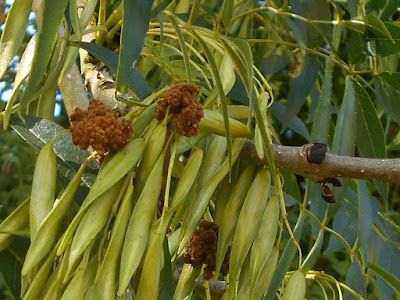 |
I arrived to find that the hay had been cut.
11 July, 2018
|
A small pool exists at the edge of field 5411. Really it is not, as far as I can establish, part of Foxhill Farm, but I strolled over, a pair of buzzards mewing overhead, to have a look. Not surprisingly the water had disappeared, but a stand of Purple Loosestrife, Lythrum salicaria, was in flower notwithstanding.
 |
Purple Loosestrife must be among the loveliest of our wild flowers.
11 July, 2018
|
Around it the tall, quite lush, grass was harbouring some insects typical of wet conditions including this green bug. Cicadella viridis is widespread and indeed this particular family, the Cicadellidae, takes its name from the genus to which this rather large (c.7mm) and distinctive species belongs.
 |
Cicadella viridis. This is a large, common and rather obvious leafhopper
of damp to wet areas. 11 July, 2018
|
Butterflies are now much more common than a month ago. Skippers were plentiful but rarely settled for more than a second or two before dashing away to chase a potential mate, so a good camera shot proved impossible. The photograph shows what is probably a Small Skipper, Thymelicus sylvestris (the underside of the antennae tips do not appear dark), but I cannot be 100% certain.
There was plenty of taller vegetation at the base of hedgerows and the hedges themselves held much of interest. Ash trees punctuated the hedgerows at irregular intervals and here, as elsewhere, the mite Aceria fraxinivora had been at work producing its brown cauliflower-like growths.
 |
Small Skipper? Anyway, it was busy nectaring at Creeping Thistle.
Foxhill Farm, 11 July, 2018
|
There was plenty of taller vegetation at the base of hedgerows and the hedges themselves held much of interest. Ash trees punctuated the hedgerows at irregular intervals and here, as elsewhere, the mite Aceria fraxinivora had been at work producing its brown cauliflower-like growths.
 |
Aceria fraxinivora is very common, attacking the 'keys' of ash trees.
Foxhill Farm, 11 July, 2018
|
Also in the hedgerows the Dog Roses were displaying 'sputnik' galls. These spiky, spherical structures are the work of a wasp, Diplolepis nervosa. Each sphere contains a single chamber carrying the larva and, later, the pupa.
 |
This odd little gall is the work of Diplolepis nervosa. Foxhill Farm.
11 July, 2018
|
Small Copper butterflies, Lycaena phlaeas, flitted around, their larval food-plant of sorrel being abundant in the hay meadows. Common these insects may be, but it was a 'first' for Foxhill Farm and pleasing to see. This pushed the invertebrates total for Foxhill Farm up to 286.
 |
Small Copper butterflies are widespread, active little insects.
Foxhill Farm, 11 July, 2018
|
No comments:
Post a Comment